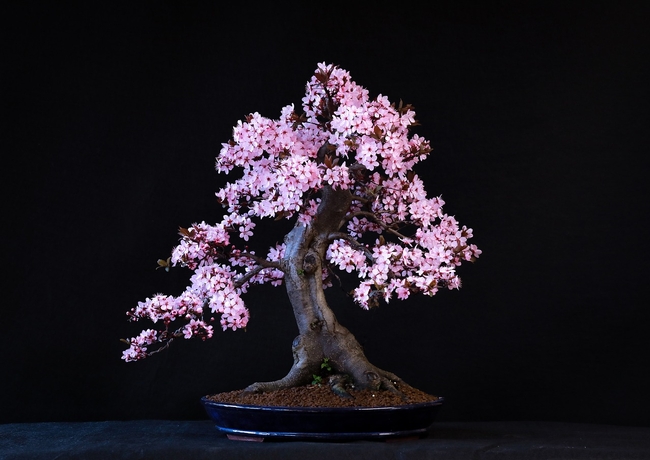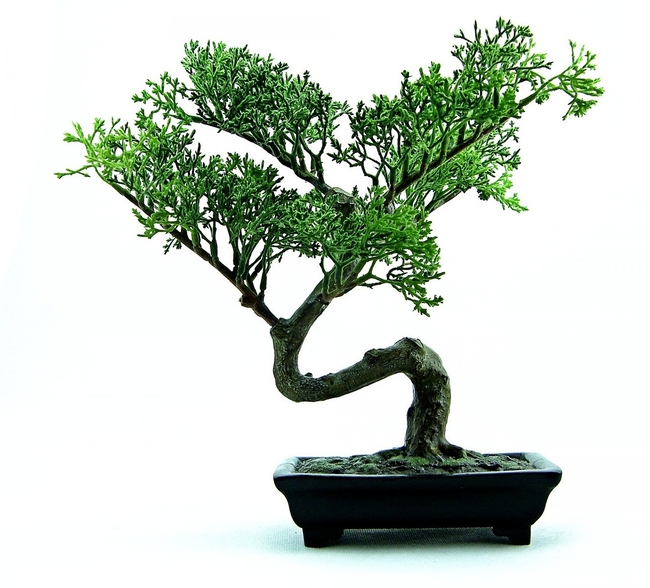- Author: Penny Pawl, UC Master Gardener of Napa County
The Napa County Master Gardeners hosted a Fall Faire last month. The event turned out to be very successful even though Mother Nature paid a visit and gave us a downpour. Both the Master volunteers running the booths and the attendees crowded under the large umbrellas, which seemed to fill up with water quickly.
The Napa Valley Bonsai Club had a display with a few examples of bonsai. Many people did not know that Napa has an active bonsai club that has been meeting for over 40 years. Faire attendees had many questions about bonsai, so I will try to give a little history of the practice.
The Chinese technique known as penjing predates bonsai, but it is also art made with living material. The first penjing tree I saw had a knot tied in the trunk, which is something that would not happen in nature.
About 700 years ago the Japanese started developing bonsai techniques with trees. Their goal was to make the tree look as natural as possible so that observers would feel like they were viewing the tree in a forest. Over the centuries, practitioners developed more rules, adding to the beauty of the art form.
Bonsai means “plant in pot” but not all plants in pots are bonsai. There are five main bonsai styles with many offshoots. One main style is known as formal upright, yielding a tree that looks like a pine or redwood in the forest. The informal upright style has some curves to the trunk, but the apex is directly over the base, or nebari in Japanese.
Another style is the slant tree which grows to either side of the nebari. A fourth style is the windswept tree, which appears crafted by the winds, with everything growing in one direction. and a final style is the cascade, a tree hanging over a cliff and formed by nature.
Bonsai trees should look old. One way to achieve this is to have exposed roots clasping the soil. The arrangement of the branches is also important.
Typically, bonsai is practiced on trees with small leaves, although, in some species, the size of the leaves can be reduced.
During World War II, some Japanese people in U.S. internment camps took up bonsai. They planted black pine seeds in coffee cans and began practicing the techniques. After the war, these same people formed clubs to learn more about the art of bonsai.
One of the most famous bonsai cultivators in our country was John Naka, considered by many to be the father of bonsai in the U.S. I saw him demonstrate the art form on a few occasions and he was quite the showman. His masterpiece, a group of trees in a forest setting, is Goshin, which is viewable at the United States National Arboretum in Washington, D.C. It honors his grandchildren. Mas Imazumi who was the teacher, or sensai, of the Napa and Santa Rosa clubs was also one of these teachers and one of his trees is on display at the Pacific Bonsai Museum in Federal Way, Washington.
Many American and British military people stationed in Japan after the war became interested in bonsai. They returned home and wanted to learn more about it. U.S. bonsai clubs, most of which had only Japanese members, soon welcomed others and started to teach the art form.
Now the art of bonsai is practiced all over the world. Online, I can view trees from Asia, Europe, South America, and the U.S. The art form is changing as new artists enter the field.
A bonsai is never finished. It is a living work that needs sunshine, water, food, attention, and occasional repotting in special soil.
California has many bonsai clubs. The Golden State Bonsai Federation is a statewide organization. There is an upcoming rendezvous in Santa Nella, California (Merced County), from October 20 to October 22. You can find more information on the organization's website. There will be demonstrations, displays and sales at this event.
Many public gardens feature bonsai, including the Bonsai Garden at Lake Merritt in Oakland. Volunteers from local bonsai clubs care for its collection of 90 trees. The displays are often changed depending on the season.
The Napa Valley Bonsai Club meets at the Napa Senior Center on the second Saturday of each month from 10 a.m. to 2 p.m. Members bring in trees to work on and they share ideas. Sometimes I go just to walk around and observe what everyone is working on. There are people of all levels of experience in these workshops. If you would like to learn more about bonsai, drop in.
Home Vineyard Workshop: Join UC Master Gardeners of Napa County's Integrated Grape Team for a workshop on “Grapevine Genetics” on Saturday, October 21, from 10 a.m. to noon, at University of California Cooperative Extension, 1710 Soscol Avenue, Napa. Learn the ins and outs of grapevine genetics from UC Davis experts Dr. Dianne Velasco and Dr. Carole Meredith. Registration required.
Gardening with the Masters: Join UC Master Gardeners of Napa County for a gardening workshop on Saturday, October 21, from 10 a.m. to noon, at Ole Health Garden Ole Health South Campus, 300 Hartle Court, Napa. Children 5 and older are welcome if accompanied by an adult. Class size is limited. Registration required.
Help Desk: The Master Gardener Help Desk is available to answer your garden questions on Mondays and Fridays from 10 am until 1 pm at the University of California Cooperative Extension Office, 1710 Soscol Avenue, Suite 4, Napa. Or send your questions to mastergardeners@countyofnapa.org. Include your name, address, phone number and a brief description.




